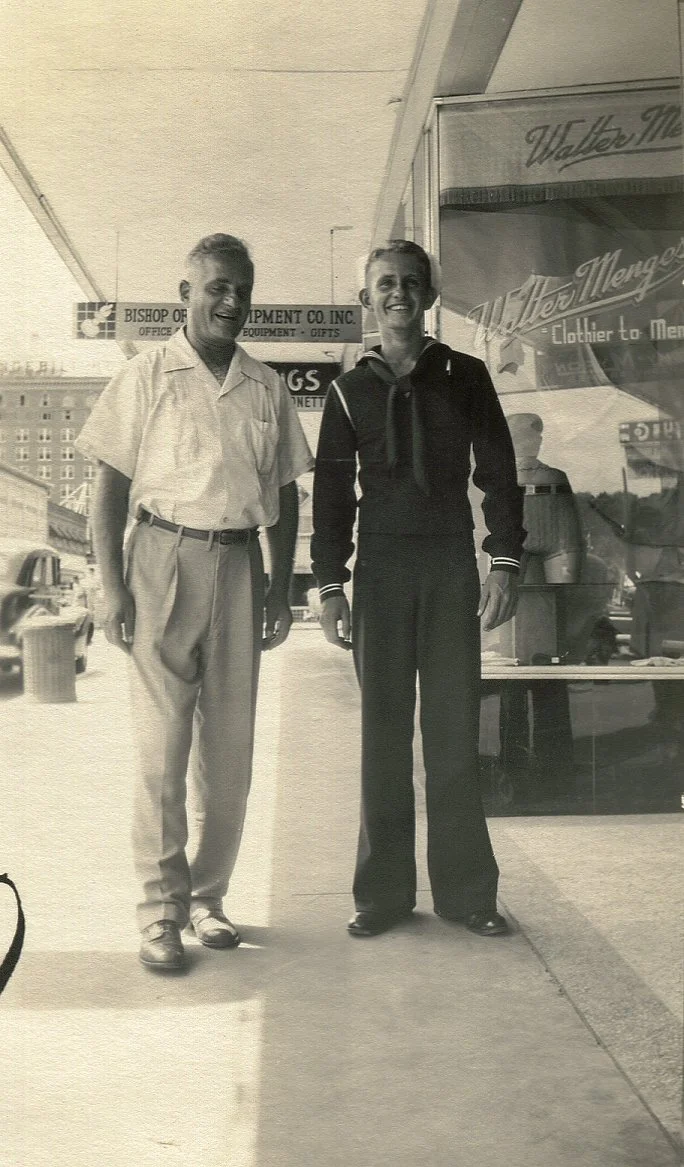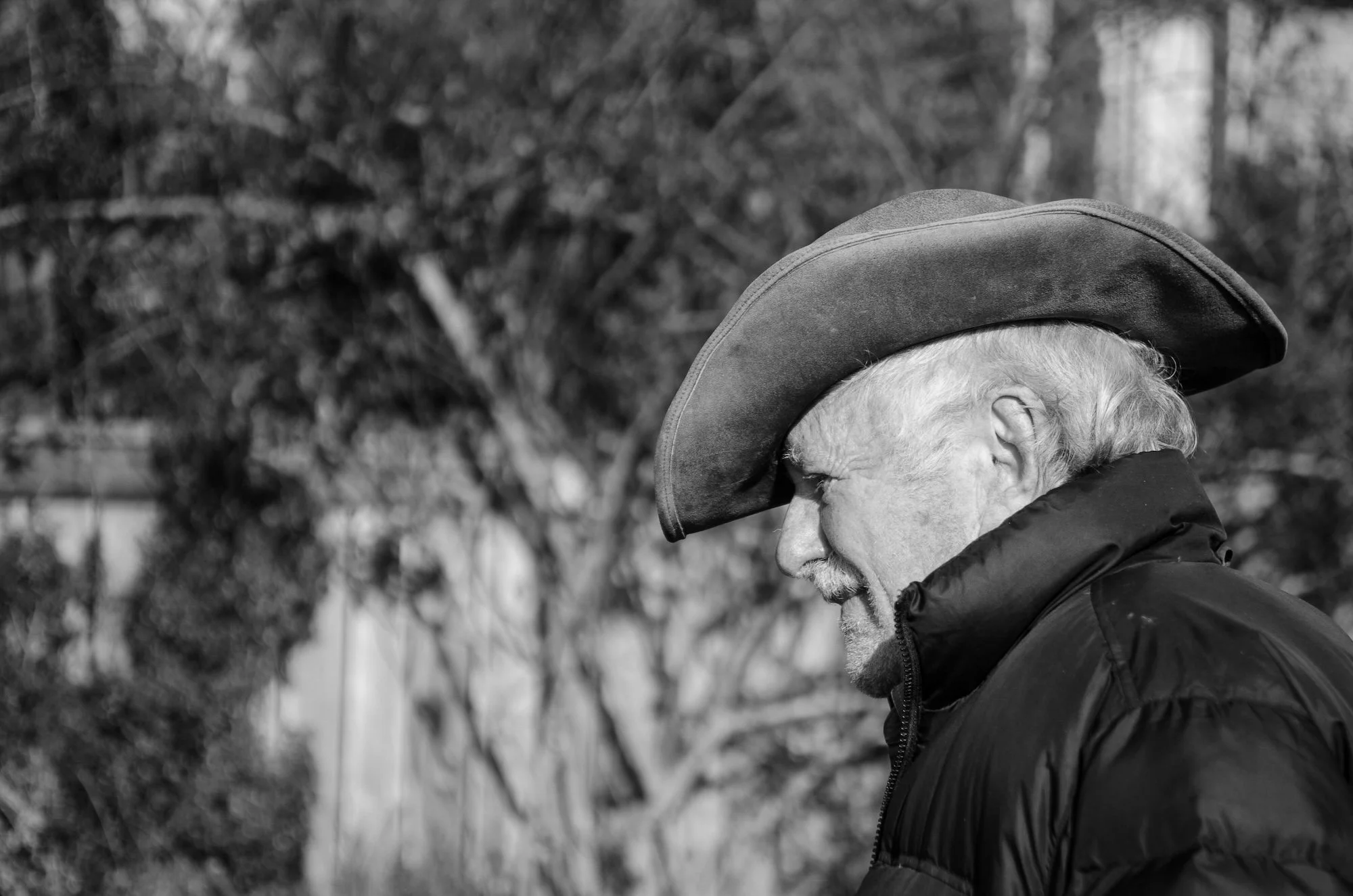
1940s
1943
“Drawing and handwork were integral to Harris’s late teenage years and early adulthood,” adds Triplett. “In 1943, six years before his summer in Provincetown, his stepmother and her sister would take him from the Orlando orange groves to Pacific Palisades, California, where he attended classes at the Chouinard School of Art (now California Institute of the Arts, or CalArts). With World War II raging, he also worked as a riveter for Douglas Aircraft in Los Angeles.”⁵
Paul Harris Archives; Paul Harris with his father, Julian, in Orlando, Florida, 1944, Paul Harris Archives
Paul Harris with his grandmother and sister Shirley in Orlando, Florida, c. 1944
1944
Graduates from Orlando High School.
Enlists in the U. S. Navy and is assigned to the destroyer USS Ault in the Pacific Theatre, which enters the Pacific war zone by year’s end.
Two Sailors Resting, 1945, pencil on paper, 9 x 11 ¾ inches
Gun Watch Sketches, 1944, pencil on paper, 12 x 9 inches
1945
Harris produces drawings of his fellow sailors, and, Triplett remarks, made “fast friends who would nevertheless endure for decades. One such pal was Servando Trujulo from New Mexico, whose descriptions of the arid and open landscape inspired Harris to enroll in the University of New Mexico following the war in 1946.”⁶
“On May 13 the Ault, stationed in the Pacific, was attacked by a kamikaze aircraft. The plane,” according to Christopher Harris, “was gunned down—ߵsplashed’ in the jargon of the Navy—by the gunner, named Johnnie—to whom Dad fed the ammunition belts. Johnnie was from an Indian tribe in New Mexico and was another lifelong friend. Dad never boasted about this event. When he spoke about it, it was only to repeat his admiration for Johnnie who stayed amazingly calm when death could have been seconds away.”⁷
On September 2, the Ault is anchored in Tokyo Bay and stationed next to the USS Missouri as the Japanese surrender takes place. Harris makes a drawing of the surrender ceremony.
1946
Contracts rheumatic fever, spends six months in various naval hospitals, and is released from the Navy in June.
Enrolls as a freshman at the University of New Mexico, Albuquerque.
1947
Hitchhikes in Mexico and Guatemala and is jailed as a vagrant in San Marcos, Guatemala. “But it wasn’t a traumatic experience,” Christopher Harris says. “He said the officials were quite courteous.”⁸
1948
Attends the New School for Social Research in New York City during his junior year. Johannes Molzahn (1892–1965), a German painter teaching at the college, becomes a key and enduring influence, especially his formal and conceptual interests in mythology and storytelling.⁹ In a radio interview in 2000, Harris will recall: “He [Molzahn] was always trying to get us to find the essence of whatever, and we worked extremely hard. For instance, he would have a glass bowl there to be drawn. And you couldn't draw the glass bowl like it was, you had to find the essence of it.”¹⁰ In the exhibition catalogue accompanying Paul Harris Sculpture, Certain Pieces, 1958–1980 that will go on view in 1981 at the Loch Haven Art Center, Orlando, Florida, Phyllis Diebenkorn will write, “Paul has said that, with few exceptions (Duchamp-Villon for one) his affinity is with painters, not sculptors. He mentions Matisse, Nolde, Morandi (particularly evident in Paul's latest work). Two other painters who have had great influence are his teachers Hans Hofmann and Johannes Molzahn. To look at the work of these two men and then at Paul's work would offer no clues. It is rather the spirit of the two men—the excitement and the love of painting and the new ways of looking which they communicated—that has influenced him.”¹¹
Hans Hofmann, Forum 49 symposium, Gallery 200, Provincetown, 1949, photograph by Bill Witt, Archives of American Art, Smithsonian Institution
1949
Becomes engaged to Marguerite Kirk.
Studies with legendary abstractionist and teacher Hans Hofmann (1880–1960) at his summer school in Provincetown, Massachusetts. Harris produces paintings and drawings, “but I knew really I wanted to be a sculptor.”¹² In a 1976 interview with Los Angeles County Museum of Art curator Maurice Tuchman for the Archives of American Art, Harris will discuss the engulfing Abstract Expressionist tendency at the time to “make something never seen before . . . an idea that was touching everyone.” Harris meets artist and writer Elaine de Kooning (1918–1989) in Provincetown. The two form a deep, enduring friendship, and Elaine will tenderly and affectionately correspond with Paul, and Meme, over the next forty years, eventually purchasing a home next to the Harris family in Bolinas, California. In the interview, Harris recalls Elaine “lived upstairs from me in an apartment [in Provincetown] of Hofmann’s and all of the New York painters in her group would come there. And so I would listen to what they said . . . it made sense to me. I had to try and figure out how I would do this in sculpture. I believed what they said, I believed their intentions. But I had to find some way I could do it.”¹³
Attends the historic Forum 49 symposium in Provincetown that explores the avant garde and contemporary American art practice.
-
⁵Triplett, “Paul Harris: Interior Interests.”
⁶Triplett, “Paul Harris: Interior Interests.”
⁷Christopher Harris, “Eulogy for Paul Harris.”
⁸Christopher Harris, e-mail interview with the author, 2025.
⁹Michele Corriel, “Self-Portraits.”
¹⁰Paul Harris, interview by Carrie Adney, College of Marin radio program, 2000, audio recording, College of Marin, Kentfield, CA, in possession of PaulHarrisArt.com, accessed August 16, 2025.
¹¹Phyllis Diebenkorn, “Reflections on the Work of Paul Harris,” (exhibition catalogue) Paul Harris Sculpture, Certain Pieces, 1958–1980, (Orlando: Loch Haven Art Center, 1981).
¹²Paul Harris, interview by Maurice Tuchman, Archives of American Art, Smithsonian Institution, 1976.
¹³Harris, interview by Tuchman.













